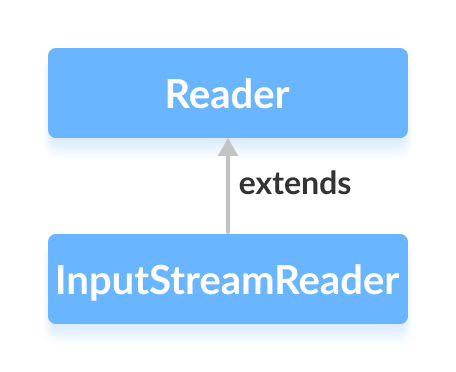java.io包的InputStreamReader类可用于将字节数据转换为字符数据。
它扩展了抽象类Reader 。

InputStreamReader类可与其他输入流一起使用。它也被称为字节流和字符流之间的桥梁。这是因为InputStreamReader将从输入流中读取字节作为字符。
例如,某些字符需要2个字节才能存储在存储器中。要读取此类数据,我们可以使用输入流读取器,该读取器一起读取2个字节并将其转换为相应的字符。
创建一个InputStreamReader
为了创建InputStreamReader ,我们必须首先导入java.io.InputStreamReader包。导入包后,便可以在此处创建输入流阅读器。
// Creates an InputStream
FileInputStream file = new FileInputStream(String path);
// Creates an InputStreamReader
InputStreamReader input = new InputStreamReader(file);
在上面的示例中,我们创建了一个名为input的InputStreamReader以及一个名为file的FileInputStream 。
在这里,文件中的数据使用某些默认字符编码存储。
但是,我们也可以在文件中指定字符编码的类型( UTF8或UTF16 )。
// Creates an InputStreamReader specifying the character encoding
InputStreamReader input = new InputStreamReader(file, Charset cs);
在这里,我们使用了Charset类来指定文件中的字符编码。
InputStreamReader的方法
InputStreamReader类为Reader类中提供的不同方法提供实现。
read()方法
-
read()-从阅读器读取单个字符 -
read(char[] array)-从阅读器读取字符并将其存储在指定的数组中 -
read(char[] array, int start, int length)-从读取器读取等于长度的字符数,并从头开始存储在指定的数组中
例如,假设我们有一个名为input.txt的文件,其中包含以下内容。
This is a line of text inside the file.
让我们尝试使用InputStreamReader读取此文件。
import java.io.InputStreamReader;
import java.io.FileInputStream;
class Main {
public static void main(String[] args) {
// Creates an array of character
char[] array = new char[100];
try {
// Creates a FileInputStream
FileInputStream file = new FileInputStream("input.txt");
// Creates an InputStreamReader
InputStreamReader input = new InputStreamReader(file);
// Reads characters from the file
input.read(array);
System.out.println("Data in the stream:");
System.out.println(array);
// Closes the reader
input.close();
}
catch(Exception e) {
e.getStackTrace();
}
}
}
输出
Data in the stream:
This is a line of text inside the file.
在上面的示例中,我们使用文件输入流创建了一个输入流读取器。输入流阅读器与文件input.txt链接。
FileInputStream file = new FileInputStream("input.txt");
InputStreamReader input = new InputStreamReader(file);
要从文件中读取字符 ,我们使用了read()方法。
getEncoding()方法
getEncoding()方法可用于获取用于在输入流中存储数据的编码类型。例如,
import java.io.InputStreamReader;
import java.nio.charset.Charset;
import java.io.FileInputStream;
class Main {
public static void main(String[] args) {
try {
// Creates a FileInputStream
FileInputStream file = new FileInputStream("input.txt");
// Creates an InputStreamReader with default encoding
InputStreamReader input1 = new InputStreamReader(file);
// Creates an InputStreamReader specifying the encoding
InputStreamReader input2 = new InputStreamReader(file, Charset.forName("UTF8"));
// Returns the character encoding of the input stream
System.out.println("Character encoding of input1: " + input1.getEncoding());
System.out.println("Character encoding of input2: " + input2.getEncoding());
// Closes the reader
input1.close();
input2.close();
}
catch(Exception e) {
e.getStackTrace();
}
}
}
输出
The character encoding of input1: Cp1252
The character encoding of input2: UTF8
在上面的示例中,我们创建了两个输入流读取器,分别名为input1和input2 。
- input1未指定字符编码。因此,
getEncoding()方法返回默认字符编码的规范名称。 - input2指定字符编码UTF8 。因此,
getEncoding()方法返回指定的字符编码。
注意 :我们已经使用Charset.forName()方法来指定字符编码的类型。要了解更多信息,请访问Java Charset(Java官方文档)。
close()方法
要关闭输入流阅读器,我们可以使用close()方法。一旦调用close()方法,我们将无法使用读取器读取数据。
InputStreamReader的其他方法
| Method | Description |
|---|---|
ready() |
checks if the stream is ready to be read |
mark() |
mark the position in stream up to which data has been read |
reset() |
returns the control to the point in the stream where the mark was set |
要了解更多信息,请访问Java InputStreamReader(官方Java文档)。